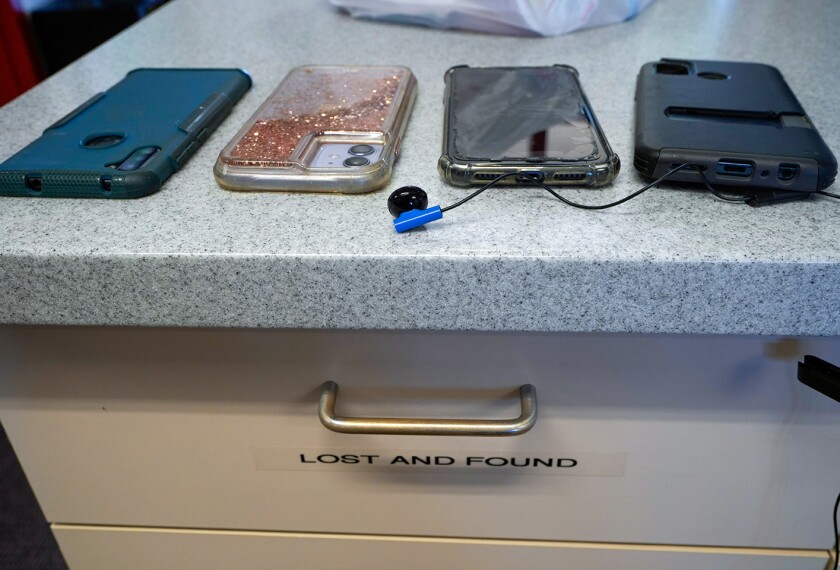As most schools offered a combination of online and in-person instruction in the 2020-21 school year, Black students and students with disabilities continued to be disproportionately disciplined.
That’s according to the U.S. Department of Education’s Civil Rights Data Collection from the first full school year impacted by COVID-19, which the department’s office for civil rights released last week.
According to data from more than 97,000 schools in 17,821 school districts—including juvenile justice facilities, multi-district magnet schools, independent alternative and special education schools, and charter school networks—inequities based on race and disability status persisted. They were present in every aspect of school discipline, including in-school and out-of-school suspensions, expulsions, referrals to law enforcement, and arrests.
In the 2020-21 school year, about 786,600 students in K-12 received one or more in-school suspensions, about 638,700 received one or more out-of-school suspensions, and about 28,300 received an expulsion. That’s significantly lower compared to the last published year of data, although Education Department officials cautioned against comparing any discipline data from the hybrid pandemic year to previous years.
According to Liz King, the senior director of the education equity program for The Leadership Conference on Civil and Human Rights, a civil rights coalition of 230 organizations nationwide, those numbers should’ve been even lower, since 88 percent of schools were functioning in a hybrid learning environment. However, the figures do highlight that hybrid education did not impact longstanding inequities in discipline, she said.
“We have often thought of the discipline data as a canary in the coal mine, as one of the most obvious examples of the way in which our racially discriminatory system of education is harming students of color, students with disabilities, and students of color with disabilities,” she said. “Discipline disparities are one manifestation of a broadly racially inequitable system.”
Here’s a national snapshot of school discipline from the 2020-21 school year data:
Preschool discipline
Racial and gender disparities in suspensions and expulsions start in preschool, according to OCR data. In 2020-21, preschool boys represented 54 percent of the total 1.2 million preschool students, but made up 81 percent of preschool children who received one or more out-of-school suspensions, and 85 percent of all students who were expelled.
Black boys accounted for just 9 percent of preschool enrollment, but represented 23 percent of preschool children who received one or more out-of-school suspensions and 20 percent of expelled children. White boys were also overrepresented in preschool discipline, accounting for 24 percent of preschool enrollment, but representing 43 percent of preschool children who received one or more out-of-school suspensions, and 47 percent of those expelled.
K-12 suspensions and expulsions
Compared to their overall enrollments, Black boys, white boys, and boys of two or more races were overrepresented among K-12 students who were suspended and expelled. In general, boys were suspended more than girls, even within the same demographic, according to the data.
Both white and Black boys were disproportionately disciplined compared with their enrollment, but Black boys were nearly two times more likely than white boys to receive an out-of-school suspension or an expulsion.
Discipline for students with disabilities
Students with disabilities were overrepresented in both types of suspensions and expulsions relative to their enrollment, according to OCR data. Despite making up 14 percent of overall enrollment, they represented 24 percent of out-of-school suspensions, 18 percent of in-school suspensions, and 17 percent of arrests.
Law enforcement referrals and arrests
The number of law enforcement and school-based arrests during the hybrid school year declined significantly compared to the 2017-18 school year, which was the latest non-pandemic year of data the Education Department has released. A school-related arrest can occur during in-person or virtual school activities. All arrests are also counted as referrals to law enforcement.
In 2020-21, Black students, white students, and students of two or more races were disproportionately referred to law enforcement or arrested, as were students with disabilities.
Bullying and harassment allegations
In the 2020-21 school year, students reported 42,500 allegations of harassment or bullying on the basis of sex, sexual orientation, race, disability, or religion. By far the most commonly reported type of bullying or harassment was on the basis of sex, followed by race.
The least common was bullying or harassment on the basis of religion, which 3 percent of all complainants alleged, according to the data.
Black students most commonly reported being bullied or harassed on the basis of race, while white students reported being harassed or bullied because of disability status.
Corporal punishment
Although more than half of U.S. states ban corporal punishment—hitting, spanking, or otherwise using physical violence against a child—more than 2,000 schools, or about 2 percent, chose to use that punishment against students, according to Ben Jones, director of legal and policy initiatives at Lives in the Balance, an organization working to end the use of restraint and seclusion in schools.
That is fewer schools compared to 2017-18, when almost 3,597, or about 3.5 percent of schools used it as a form of discipline.
In March, U.S. Secretary of Education Miguel Cardona issued a letter urging schools to move away from the practice of using physical violence against kids, citing research and alternative models to respond to student behavior.
“Schools should be safe places where all students and educators interact in positive ways that foster students’ growth, belonging, and dignity—not places that teach or exacerbate violence and fear,” he said in the letter. “Let’s all work together to move away from this harmful practice and to create learning environments that are safe and supportive for all students.”
According to 2020-21 data, 99 percent of the schools that hit children were concentrated in ten states: Alabama, Arkansas, Florida, Georgia, Louisiana, Mississippi, Missouri, Oklahoma, Tennessee, and Texas.






